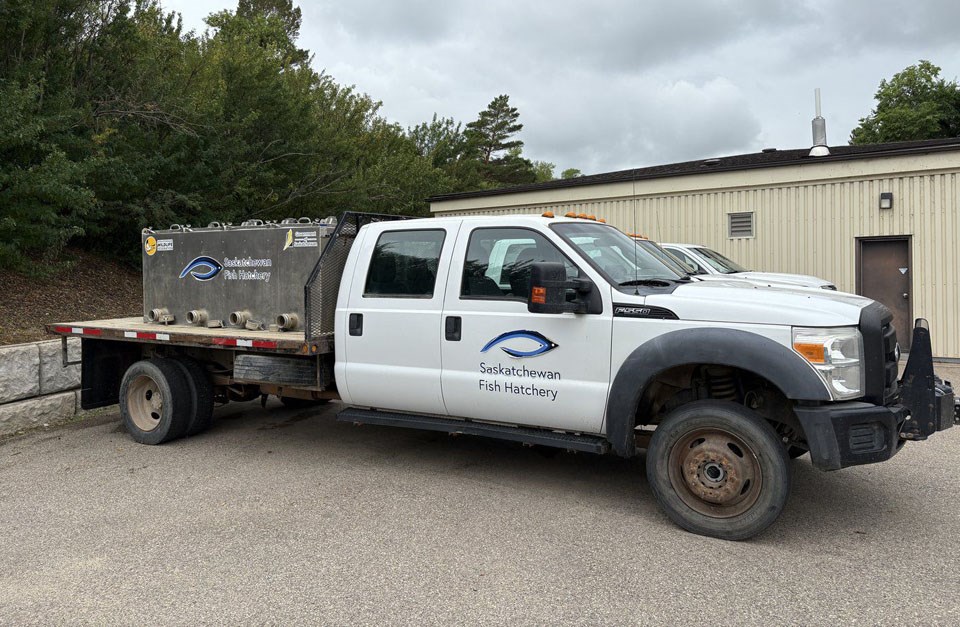ECHO LAKE — The next time you cast your fishing rod, you might want to think about where the fish that populate Saskatchewan’s 100,000 lakes have originated. While some are native species and maintain their population naturally, many are not and have had a helping hand in arriving at your favourite fishing spot.
The Saskatchewan Fish Hatchery, Saskatchewan's only aquaculture facility producing fish for public sport angling opportunities, is situated along Echo Lake near Fort Qu’Appelle. Operated by the Saskatchewan Wildlife Federation (SWF), the hatchery is celebrating 110 years of raising Trout and Walleye to populate as many as 200 public fishing waters in the province to enhance public angling.
Before 2014, the provincial government operated the hatchery. The facility employs seven permanent year-round employees and two summer staff and still works closely with the Ministry of Environment and other stakeholders to manage the spawning, collection of eggs and sperm, fertilization, growth and release of Walleye and various Trout species. Administered by SWF, operating costs are covered by Saskatchewan’s Fish and Wildlife Development Fund, which receives 30 per cent of its revenue from all fur, angling and hunting licences sold in the province.
In Southwest Saskatchewan, public waters stocked by the Hatchery include Battle Creek, Belanger Creek, Five Mile Dam (south of Gull Lake), Loch Leven and Bone Creek, to name a few. The hatchery produces fish and stocks waters according to the Ministry of Environment, Fisheries Biologists' requirements. The 2024 Stocked Waters Guide, available on the Ministry’s website, indicates that a total of 8,736,592 fish were stocked in 145 waters with roughly 8.3 million of those being walleye and the remainder trout (brook, brown, lake and rainbow). Splake and tiger trout may also be raised and stocked.
Free tours to the public are available at the facility seven days per week, including holidays, from May 1 until September long weekend. However, visitors will not see too much action at the facility after the middle of June, once the fingerlings are released into public waters across the province.
“We are at our peak with fish in our facility from May until the first or second week of June when we head out to stock fish,” Rachel Birns, program support officer, explains.
“If you want to see walleye hatching out of the jars, the May long weekend until the first week of June is the best time to visit. Quite a few school groups come through at that time. During the summer, we do invite visitors to view our stock of adult trout in our outdoor pond, which we carry over and release later.”
The facility’s busy season starts in the fall with the spawning of trout. Once the eggs hatch, staff maintain the fish, treat them once a week to prevent disease and split them into large tubs as they grow into fingerlings, to give them more space. Walleye spawn camp takes place in April at Buffalo Pound. This involves hatchery staff, fisheries biologists and other stakeholders, including the Department of Fisheries and Oceans, Water Security Agency and the University of Regina sport fish research team.
“It takes all hands on deck for Walleye spawning. Walleye are the most popular angling fish in the province as they’re fun to catch and have a good taste,” Birns explains
Although the hatchery is located in the Qu’Appelle Valley, fish are not stocked in the local waters
“The Qu’Appelle Valley has a rich native species system, so we don’t put trout in there as they would compete for food,” Birns says
“Trout usually get their own systems that are fairly contained, so they can’t travel and mix with native species. Ninety-nine per cent of the trout stocked will not be able to reproduce, as the waters they are stocked into don't have the proper spawning habitat. Trout need cool, fast-flowing water and rocky areas.
Lake trout is the only trout native to the province, and it’s found further north in colder, deeper water.
This year’s forest fires have impacted original plans for stocking.
“Some of our biggest trout destinations are Narrow Hills and Clarence-Steepbank Lakes Provincial Parks, Creighton and La Ronge,” Birns explains.
“We couldn’t go there due to the fires and had to reallocate up to 40 per cent of our trout to other waters. We hope to pick up where we left off next year.”
The furthest destinations are north of La Loche and are a 14-hour drive from the hatchery.
Trout fingerlings are placed in a truck for transport. Walleye are so tiny that they go in smaller containers.
"Walleye face many challenges in their natural environment,” Nelson Bergh, manager at the facility, says.
“From suffocation as an egg due to sediment to a variety of predators that will eat them once hatched. The hatch rate for walleye at the Saskatchewan Fish Hatchery is often much higher because the eggs are protected and in a controlled environment."
As soon as the walleye fry hatch, they need to get out to the lake to feed. Each hatchling is the size of an eyelash.
“We think that 10 per cent or less survive, but it varies water to water,” Birns says.
“They are so fragile and vulnerable. If we release 10 million walleye per year, we estimate that one million will survive. Trout can live at the hatchery for a longer period, where they eat commercial food and are released at three to six months old. They are bigger and their immune system is developing, so they have a much higher survival rate.”
Birns encourages anyone to visit the centre during their summer season, or by appointment at other times of the year, to learn more.
“It’s a nice story for everyone, regardless of their background. Everyone seems to appreciate what we do. A lot of people don’t realize where their Trout is coming from. The trout wouldn’t be there if we weren’t putting them there.”
Find Saskatchewan Fish Hatchery on Facebook to follow their work and for updates on hatching.




